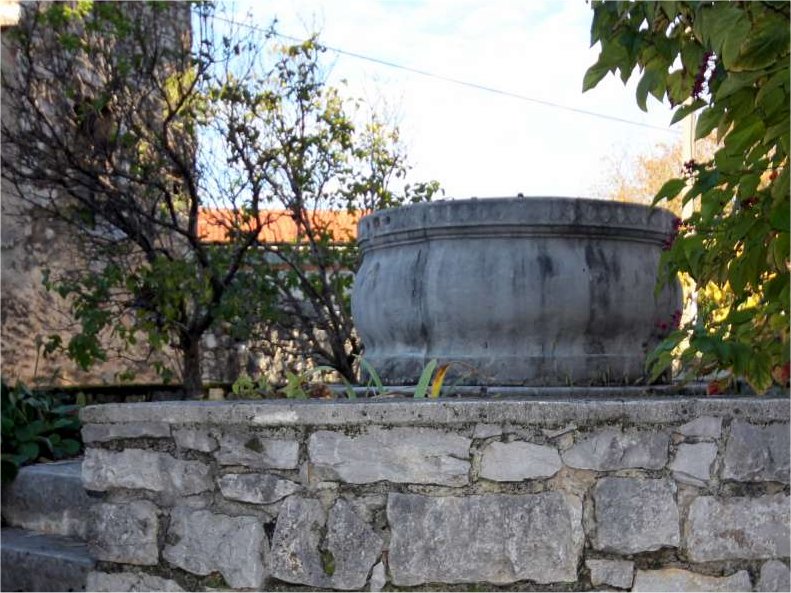
Old well
Rainwater used to be the only source of drinking water in Karst because in this area, few surface water sources can be found.
The people were very creative and started collecting water in wells (“štirna”) and ponds. Numerous wells can still be found in Karst villages and they add a special character to our area.
Village wells had a significant connecting effect on the locals, demonstrating their unity. Each house could not afford its own well, with the exception of individual rich homesteads.
Deep underground, each well has its own water reservoir. Above the ground, it consists of the stone base and the well body. Most of well bodies were assembled from several stone parts. However, some existed that were made from one piece and were usually owned by the richest people.
On the outside of the well, you can usually find an inscription with the year of making and sometimes the name of the owner or the stonecutter. Only a few wells also include a relief.
The people were very creative and started collecting water in wells (“štirna”) and ponds. Numerous wells can still be found in Karst villages and they add a special character to our area.
Village wells had a significant connecting effect on the locals, demonstrating their unity. Each house could not afford its own well, with the exception of individual rich homesteads.
Deep underground, each well has its own water reservoir. Above the ground, it consists of the stone base and the well body. Most of well bodies were assembled from several stone parts. However, some existed that were made from one piece and were usually owned by the richest people.
On the outside of the well, you can usually find an inscription with the year of making and sometimes the name of the owner or the stonecutter. Only a few wells also include a relief.
|
he communal well that can be found in Dutovlje in the lower village has the year 1848 inscribed as well as a relief with the Christ’s monogram (IHS), showing a heart with a cross on the top and flowers at the sides.
With social changes in 1848, feudalism was abolished and farmers were able to partially buy the land, becoming its owners. The water supply that was put in operation in 1915 reached some of the Karst villages but not Dutovlje. Its builders wanted to take a shortcut to reach the soldiers that were dying of thirst on the front-line. This is how Dutovlje and Godnje received water from Nanos as soon as in 1916. In 1934, the water supply was extended from Godnje to Kreplje. In the construction of reservoirs, the main material was stone which was brought from the nearby quarries. The largest quarry in Karst was in Kopriva. The Dutovlje quarries were located in Kamne Gorice and the lower village. The Kamne Gorice quarry produced a hard stone with small and dense shellfish fossils. The stonecutters from Dutovlje were very appreciated and sought after and several of their masterpieces can be found throughout the village. Each winter, villagers made the best of their free time and used lime kilns to burn lime. |
Dialect words:
“štirna” = well
“kavadorji” and “štancarji” = stonecutters
“štirna” = well
“kavadorji” and “štancarji” = stonecutters
Sources:
Mira CENCIČ, Villages in the hart of Sežana Karst: Dutovlje, Kreplje in Godnje, Kras, 118/119, 2012
David TERČON, Dutovlje – 25 years of the Teran Wine and Prosciutto Festival, Sežana 1996
Verbal source: Bogdan ŠPACAPAN
Photograph: Miloš Stankovič
Mira CENCIČ, Villages in the hart of Sežana Karst: Dutovlje, Kreplje in Godnje, Kras, 118/119, 2012
David TERČON, Dutovlje – 25 years of the Teran Wine and Prosciutto Festival, Sežana 1996
Verbal source: Bogdan ŠPACAPAN
Photograph: Miloš Stankovič
